Cooking sugar
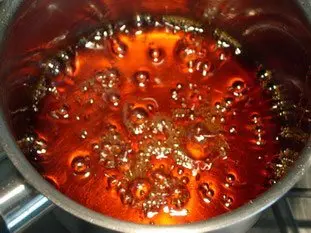
Cooking sugar, which is one of the basics of patisserie and sweet-making, is a delicate operation in which sugar is heated from 100°C or 212°F to 180°C or 356°F. Here is some information on this tricky subject.
[Translator's note: the terms used below correspond to the French tradition, as often used by English-speaking chefs, but there are other stages and terms in other traditions. Best to use a thermometer, and be guided by temperature, as the English terms commonly used in domestic cooking cover less precise stages, broader temperature ranges, and so could lead to confusion.].
[Translator's note: the terms used below correspond to the French tradition, as often used by English-speaking chefs, but there are other stages and terms in other traditions. Best to use a thermometer, and be guided by temperature, as the English terms commonly used in domestic cooking cover less precise stages, broader temperature ranges, and so could lead to confusion.].
506 K 2.6/5 (154 reviews)
Last modified on: April 3rd 2019
For 4 pieces, you will need:
- 1
 200 g caster sugar
200 g caster sugar - 2
 3 tablespoons water
3 tablespoons water - 3
 5 drops lemon juice
5 drops lemon juice - Total weight: 245 grams
Change measures:
Times for this recipe
Preparation: 5 min.
Cooking: 40 min.
All in all: 45 min.
If you start now, at , you will finish around : ?.Change start time
To finish around 7pm, you'll need to have started before: .Change end time
Step by step recipe
Stage 1 - 5 min.
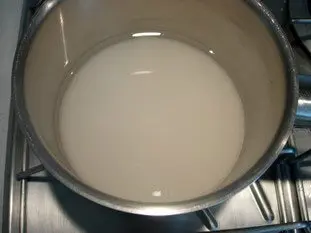
You will also need a sugar thermometer ( up to 200°C or 392°F) or even better, an electronic thermometer.
Pour water, a few lemon juice (or vinegar) drops, and sugar into a pan.
The exact volume of water doesn't matter, because sugar starts to cook only when all the water is evaporated. So it's not necessary to use very much water.
Pour water, a few lemon juice (or vinegar) drops, and sugar into a pan.
The exact volume of water doesn't matter, because sugar starts to cook only when all the water is evaporated. So it's not necessary to use very much water.
Stage 2 - 10 min.

Put the pan on high heat with thermometer in, and bring to the boil.
You will notice that for quite a long time, the temperature will stay around 100°C or 212°F, that will be the case as long as there is still any water remaining with sugar.
You will notice that for quite a long time, the temperature will stay around 100°C or 212°F, that will be the case as long as there is still any water remaining with sugar.
Stage 3
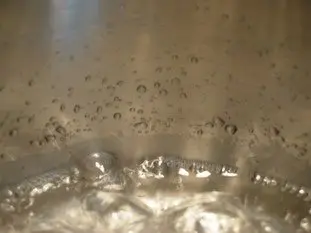
For the following stages, you will probably see some impurities coming out of the sugar that will stick round the sides of the pan.
Stage 4
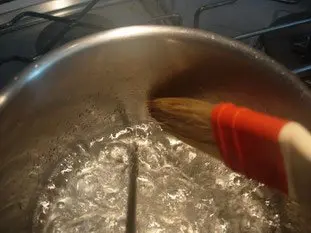
As they heat they will eventually burn and might add a bitter taste to the sugar. You can remove them with a brush dipped in clean cold water.
Stage 5 - 5 min.
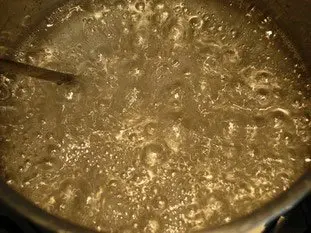
Stage 1: 106°C or 223°F, sugar is cooked to "thread" stage (used for some jams for example).
Stage 6 - 3 min.

Stage 2: 110°C or 230°F, sugar is cooked to "pearl or soufflé" stage (used for other jams and blackcurrant liqueur for example).
Stage 7 - 3 min.
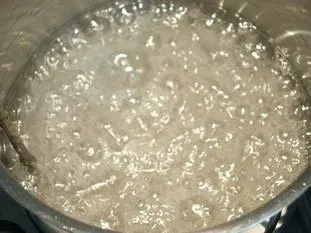
Stage 3: 118°C or 244°F, sugar is cooked to "soft ball" stage (used for Italian meringue for example).
Stage 8 - 3 min.
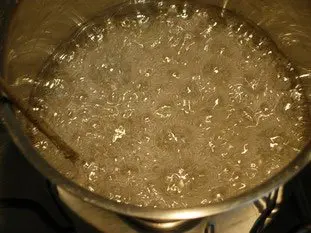
Stage 4: 125°C or 257°F, sugar is cooked to "hard ball" stage.
Stage 9 - 3 min.
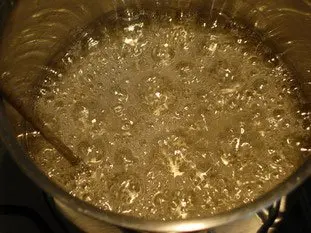
Stage 5: 135°C or 275°F, sugar is cooked to "soft crack" stage (it sticks to your teeth).
Stage 10 - 3 min.

Stage 6: 140°C or 284°F, sugar is cooked to "crack" stage (no longer sticky and it snaps).
Stage 11 - 3 min.
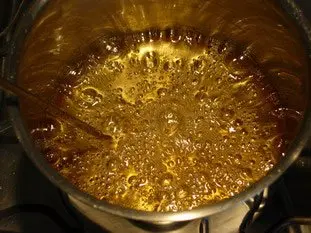
Stage 7: 155°C or 311°F, sugar is cooked "hard crack" stage (it snaps like glass).
Stage 12 - 3 min.

Stage 8: 160°C or 320°F, sugar is now "light caramel" (straw-coloured).
Stage 13 - 2 min.

Stage 9 (and final): 180°C or 356°F, light caramel becomes "dark caramel" (it's coloured). You should cool it and use it immediately, because it will continue cooking a little further, even off the heat.
Be careful: beyond 190°C or 374°F, caramel starts to smoke, burns and is spoiled.
Be careful: beyond 190°C or 374°F, caramel starts to smoke, burns and is spoiled.
Remarks
Cooking sugar is a delicate operation due to the high temperature, working with caramel at 180°C or 356°F can be very very dangerous. This why this is one of the only recipes on the site that you should make without any children around you.
In former times (not so long ago) patissiers had no thermometer, so to know the temperature of the sugar they dipped two fingers in water then in the cooking sugar, and then by touching their fingers together then releasing, they could tell by the behaviour of the sugar what stage it was at: thread, soft ball, hard ball, etc. That's the origin of the strange names of the stages.
Lemon juice drops are there to prevent sugar from brutal not wanted crystallization. I thougt it was a legend, so I don't put in, until it really happen to me when I was preparing a red sugar :
In former times (not so long ago) patissiers had no thermometer, so to know the temperature of the sugar they dipped two fingers in water then in the cooking sugar, and then by touching their fingers together then releasing, they could tell by the behaviour of the sugar what stage it was at: thread, soft ball, hard ball, etc. That's the origin of the strange names of the stages.
Lemon juice drops are there to prevent sugar from brutal not wanted crystallization. I thougt it was a legend, so I don't put in, until it really happen to me when I was preparing a red sugar :
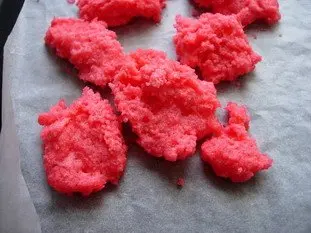
Pretty, but not usable...
Source: Gaston Lenôtre.
Nutritional information
| Proteins (gr) | Carbohydrates (gr) | Fats (gr) | Energy value (in k-calories) | Energy value (in k-joules) | |
|---|---|---|---|---|---|
| Whole recipe | 0 | 200 RDI=20 % | 0 | 800 RDI=40 % | 3,350 RDI: 40 % |
| Per 100 g | 0 | 80 RDI=8 % | 0 | 330 RDI=20 % | 1,370 RDI: 20 % |
| Per piece | 0 | 50 RDI=5 % | 0 | 200 RDI=10 % | 840 RDI: 10 % |
How much will it cost?
- For 4 pieces : 0.20 €
- Per piece : 0.05 €
Note: Be careful, these prices are only an estimate, you can consult the table of prices by ingredients used for this estimate.
This recipe uses (among others)

Caster sugar
Like these other recipes: Pistachio panna cotta with custard, Tatin apples with mascarpone cream, Clementine cake, Caramelized apple rice pudding, Tatin apple diplomat tart, ... See them all 361

Lemon juice
Like these other recipes: Julia salad, Crispy potato and mushroom brik rolls, Thin summer tart "à la grecque", Beetroot and cream cheese verrines, Lebanese-style chickpea salad, ... See them all 70

Water
Like these other recipes: Fillet of beef in a rosemary crust, Stewed plums, Chicken nems, Nonettes, Toffee apple upside-down cake, ... See them all 136
Other recipes you may also like
Pear tart with almond cream
This is a very quick and easy tart to make, as everything (or almost) can be done in advance. A piece of sweetcrust pastry, some almond cream and pears? You have "everything you need". March 17th 2011371 K4.3 1 hour 15 min.
Financiers
This delicious little cake gets its name from its shape, in the form of a gold ingot. April 14th 2020339 K 24.6 20 min.
Herb salad
Herb salad is a small salad made with leaves of all kinds of aromatic herbs, it's highly flavoured, and should be considered almost as a condiment. It really is a salad, the leaves are not chopped. October 13th 2010235 K4.6 25 min.
Chocolate mousse
Here is a simple quick recipe for chocolate mousse. It is just necessary to be careful at the final stage, when mixing the melted chocolate and the beaten egg-whites. February 21th 2011483 K3.7 40 min.
Pitta bread
This Lebanese speciality is made as a flat round pocket, which can be filled with all manner of things. January 8th 2025534 K 14.5 2 hours 50 min.
News list of cooking-ez.com
Sign up to receive the latest recipes (next batch due to be sent on 2025-09-07)
Note: We'll never share your e-mail address with anyone else.
Post a comment or question
Follow this recipe (as 9 people already do)
If you are interested in this recipe, you can "follow" it, by entering your email address here. You will then receive a notification immediately each time the recipe is modified or a new comment is added. Please note that you will need to confirm this following.
Note: We'll never share your e-mail address with anyone else.
Alternatively: you can subscribe to the mailing list of cooling-ez.com , you will receive a e-mail for each new recipe published on the site.




